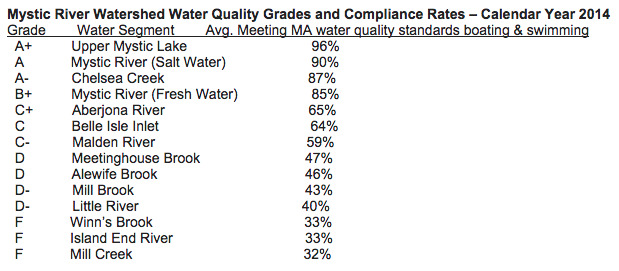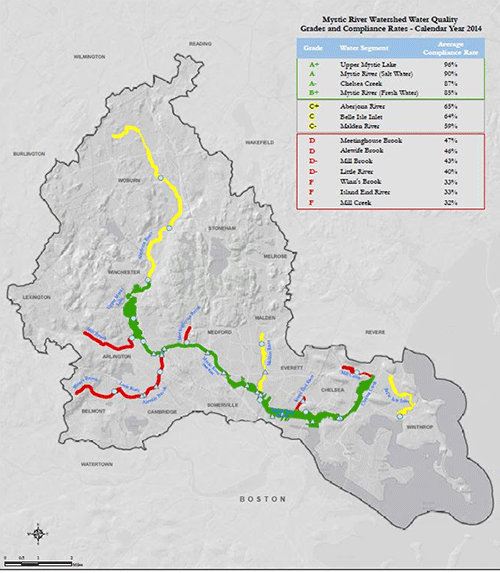New Grading System for Mystic River Watershed Yields More Localized Data
In coordination with the Mystic River Watershed Association (MyRWA), EPA is utilizing an enhanced, more locally-specific analysis of water quality in the Mystic River Watershed to illuminate environmental conditions for the public. Instead of one grade for the entire watershed, EPA and MyRWA are issuing grades for each segment of the watershed, totaling 14 separate stretches of river and its tributaries.
The grades are based on bacterial contamination found in analyzed samples that were collected by MyRWA volunteers over the past year at fifteen monitoring sites throughout the entire watershed, as well as data collected at numerous locations by the Massachusetts Water Resources Authority (MWRA). While an overall grade was created in 2006 to track water quality progress in the Mystic River Watershed, the amount of data now collected each year supports an improved and more sophisticated grading system, where a grade can be assigned, using similar criteria as in the past, to each major segment or tributary in the Mystic River watershed.

Analysis of the data has brought to light the fact that water quality in the main stem of the Mystic River, including the Upper and Lower Mystic Lakes, is quite good on a regular basis. On the other hand, water quality in many of the urban tributary streams in the Mystic River watershed is poor. Water quality in the main stem of the river from the Mystic Lakes, through Medford Square, and on to Boston Harbor, meets water quality standards nearly all of the time, especially in dry weather. However, water quality in many of the tributary streams feeding the Mystic often do not meet water quality standards. Water quality is frequently poor due to bacterial contamination in tributary streams such as Winn’s Brook, Little River, Mill Brook, the Malden River, the Island End River, and Mill Creek, even in dry weather. Investigations to date indicate the main causes of high bacteria counts in these water bodies to be illicit sewer discharges to storm drain systems and uncontrolled urban stormwater runoff that contains pet and animal waste.
A second change to the grading system is that a three-year rolling average will now be used to calculate the grade for each segment. A grade for each year is calculated in the same manner as in the past; however, the current year’s grade is averaged with the prior two years to produce the “rolling†three-year average. Such a system allows for a more complete and accurate assessment of recent water quality and is designed to better address climate variability from year to year, while allowing for real data trends to be more easily discerned.
“Grading the watershed by segments provides the public with a more accurate assessment of local water quality conditions and greater transparency for all stakeholders,†said Curt Spalding, regional administrator of EPA’s New England office. “It also helps EPA, MyRWA and other agencies to focus our efforts on the segments with lower water quality. We also hope local communities will step up efforts to reduce illicit discharges.â€
“This new grading system provides a better understanding of water quality conditions in the Mystic River watershed,†said EkOngKar Singh Khalsa, Executive Director of the Mystic River Watershed Association. “It illustrates that recreational boating in both the salt and fresh water sections of the Mystic River is safe nearly all the time and that swimming in the Mystic Lakes is highly recommended. We hope this new data will inspire many more people to enjoy this valuable natural resource and encourage further investment in the protection and restoration of the local natural environment.â€
Throughout the past year there were continued efforts to improve water quality conditions in the Mystic River watershed. Both EPA and the Mass. Dept. of Environmental Protection (MassDEP) continue to pursue a number of active enforcement actions targeted at improving water quality throughout the watershed. These enforcement efforts have resulted in the removal of over 31,000 gallons per day of sewage from storm drains in the Mystic River Watershed (nearly double the volume reported last year). Numerous additional illicit connections have been identified and are scheduled to be removed this year. A number of additional repairs have been made that have prevented tens of thousands of gallons of sewage from discharging to the river during rain events. These aggressive efforts continue to address violations of water quality with regard to bacteria.
“This new methodology will be a very helpful tool,” said MWRA executive Director Fred Laskey. “It will provide a roadmap to point out remaining water quality issues in the Mystic.”
“From park improvements to new pedestrian paths to large scale removal of invasive water chestnut plants choking the river, DCR has joined in the campaign to improve the Mystic. We will continue our efforts with partners to make further improvements to the river and park surroundings,” said Jonathan Yeo, Director, Division of Water Supply Protection at the Massachusetts Department of Conservation and Recreation.
“We are very excited for this new report card style. Its detailed ratings will help our residents understand what parts of the watershed are safe and available for recreation, and at the same time provide the details we need on where to focus our efforts. We appreciate all the help we have received from our federal, state and nonprofit partners to get us to this place, and we look forward to future efforts to bring the whole watershed up to the same beautiful conditions as the Mystic Lakes,” said City of Medford Mayor Michael J. McGlynn.
“As an urban community with the unique position of having a well-utilized waterfront, Somerville recognizes and works to support ongoing efforts to keep our waterway clean and safe. We are reclaiming the Mystic as a recreational and environmental jewel. I commend the EPA and MyRWA for their work in this area and look forward to our continued partnership,†said City of Somerville Mayor Joseph Curatone.
In a separate effort from our report card for bacteria, EPA recently launched a Mystic River water quality monitoring buoy in front of the Blessing of the Bay Boathouse in the City of Somerville. This buoy measures a number of water quality parameters such as temperature, dissolved oxygen, pH, turbidity, specific conductance, and chlorophyll that can be viewed by the public in near real time. The data will be available on EPA’s Mystic River Website. In addition to providing real-time water quality data to the public, the buoy will be used to monitor for and track cyanobacteria (blue-green algae) blooms.
EPA continues to foster a long-term effort to improve this watershed, including continued support of the Mystic River Watershed Initiative Steering Committee. The Steering Committee includes EPA and MyRWA representatives, as well as representatives from numerous public advocacy groups and municipalities from throughout the Mystic River watershed. The mission of the Steering Committee is to serve as a coordinating and information-sharing body to help establish strategic direction and priorities, as well as to recommend and promote key projects and actions needed to improve environmental conditions in the Mystic River Watershed.
More information on EPA’s Mystic River Watershed Initiative (http://www.epa.gov/mysticriver)

– Information from the New England Regional Office of the U.S. Environmental Protection Agency. Photo courtesy State Senator Pat Jehlen.